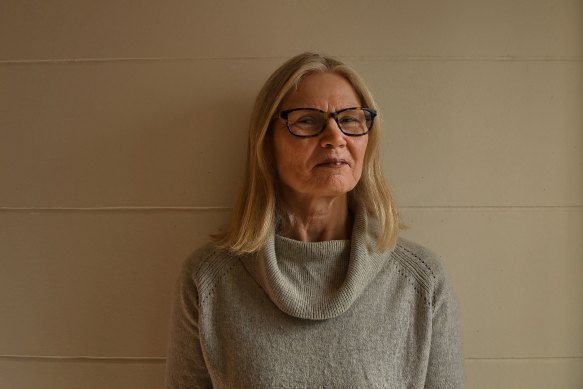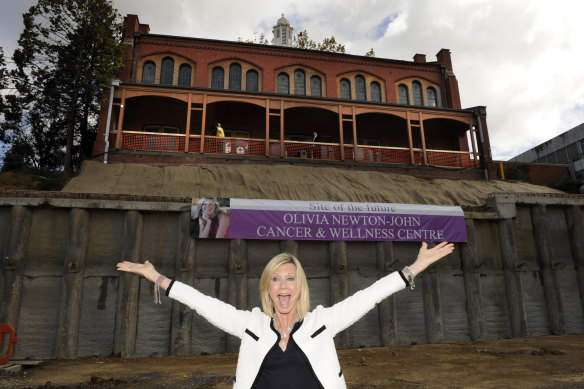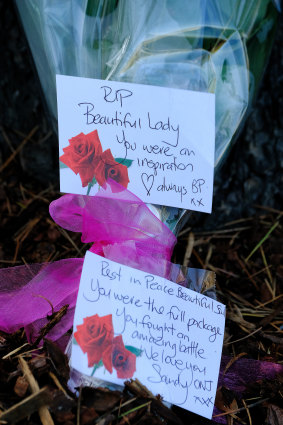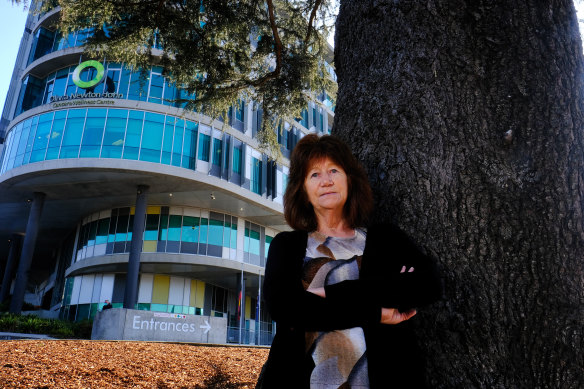Australian survival rates from breast cancer have improved in leaps and bounds since Olivia Newton-John was first diagnosed in 1992. More than 90 per cent of patients live past five years. However, there is one significant exception.
People with metastatic breast cancer, which Newton-John had lived with since 2017, can be treated but rarely cured. Sometimes those with the condition are left feeling out of place and unsupported.
Dr Andrea Smith is still working full time, despite being diagnosed with metastatic breast cancer. Credit:Kate Geraghty
“People think that breast cancer is very survivable, which it is in some ways, but the reality is more than 3000 people die from breast cancer every year in Australia,” says Dr Andrea Smith, an academic with the University of Sydney. A mother of three, she was diagnosed with stage four metastatic breast cancer six years ago.
“All of those people are dying from metastatic breast cancer,” she said.
By being open about her metastatic diagnosis, breast cancer advocates said, Newton-John had continued to help break down misconceptions about the disease, something she’d begun when she was first diagnosed 30 years ago, when breast cancer wasn’t spoken about so openly.
It also brought to the fore an issue that was central to Newton-John’s advocacy: not just treating the disease but “looking after a person’s mind, body and spirit”.
Olivia Newton-John in 2010, following an announcement that funding had been allocated for the cancer centre.Credit:Penny Stephens
The cancer centre that Newton-John lent her name to at the Austin Hospital from 2012 was among the first in Australia to bring the concept of “wellness” together with treatment and research into the disease.
The Austin, which has been treating patients with cancer since the 19th century, decided in the early 2000s to consolidate its treatment and research centres in what became the Olivia Newton-John Cancer Wellness and Research Centre.
Flowers outside the Austin Hospital Olivia Newton-John Cancer Wellness and Research Centre on Tuesday.Credit:Luis Ascui
Because Newton-John had been a high-profile cancer patient, she was approached to help with fundraising, with dramatic success. The centre was opened as a result of a combination of government and philanthropic support and hundreds of thousands of community members donating $17 million.
Professor Jonathan Cebon, formerly the medical director of cancer services, was on the team that developed the centre.
Cebon said Newton-John came from a family of scientists – her grandfather was Nobel-prize winning quantum physicist Max Born, her uncle Gustav Born was a medical researcher at Oxford, and her brother Hugh was a highly regarded infectious diseases specialist. As a result, she understood the importance of research.
But in her own cancer journey, she’d also recognised that being able to look after the whole person was important, along with the best cancer treatments offered by hospitals.
“When she got cancer, she meditated and accessed a range of other natural therapies, which helped her cope physically and emotionally alongside conventional therapy,” Cebon said.
Newton-John found she had the means to easily access these complementary treatments and was keen to make them more broadly available.
She made the creation of a wellness centre and program conditional on her support. “Her concept was you want to make those sorts of supportive therapies available to people whoever they are, not just the rich,” Cebon said.
“You could argue she was a bit of ahead of her time,” said Dr Belinda Yeo, an oncologist at the centre and scientist at the Olivia Newton-John Cancer Research Institute.
“If you walked into a big public hospital 10 or 15 years ago, it would be pretty unlikely that there would be a centre where you could have a massage or go to a meditation session or have acupuncture because you have hot flushes from your treatment.”
Newton-John herself was a patient at the cancer centre last decade, after she had attended one of its fundraising walks and was later admitted.
Since Newton-John was diagnosed in 1992, there has been a more than 15 per cent improvement in breast cancer survival rates in Australia.
But Smith, from the University of Sydney, said that shouldn’t distract from the need to improve support for those with an incurable form of the disease.
Smith, who is also a consumer representative for the Breast Cancer Network Australia, said she knew many people who didn’t have access to a breast care nurse or support group, despite improvements in treatment meaning they are living longer.
“I often say that I have more in common with people who have stage four metastatic lung cancer … than I do with people with early breast cancer,” she said.
Christine Brain outside the Olivia Newton-John cancer centre in Heidelberg.Credit:Luis Ascui
Victorian cancer patient Christine Brain on Tuesday said she was devastated by Newton-John’s death.
“Her journey, her positivity, it just gave us hope,” said Brain, 57.
She has been receiving treatment for chronic myeloid leukaemia at the centre since 2016. Every three or four months, she drives four hours from her home in Koondrook, on the Murray River in Victoria’s north, to Heidelberg for treatment.
Her husband, Paul, is also being treated there for non-malignant tumours on his back.
Brain said the Olivia Newton-John centre had been a haven while undergoing treatment and that she valued visiting the wellness centre to chat to other patients before appointments.
“You feel at ease. It’s like a haven, the wellness centre. It takes your thoughts away from the treatment.”
The Morning Edition newsletter is our guide to the day’s most important and interesting stories, analysis and insights. Sign up here.
Most Viewed in National
From our partners
Source: Read Full Article



